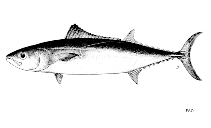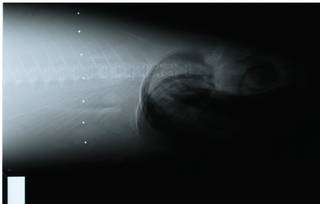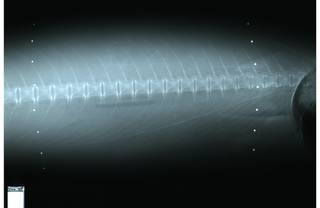WoRMS taxon details
Allothunnus fallai Serventy, 1948
219707 (urn:lsid:marinespecies.org:taxname:219707)
accepted
Species
Gasterochisma fallai (Serventy, 1948) · unaccepted
marine, brackish, fresh, terrestrial
Serventy, D. L. (1948). Allothunnus fallai a new genus and species of tuna from New Zealand. <em>Records of the Canterbury Museum.</em> v. 5 (no. 3): 131-135, Pls. 28-29. [details]
Description An occasionally schooling species which feeds mainly on krill (euphausids), and also on squids and small fishes. Juveniles...
Description An occasionally schooling species which feeds mainly on krill (euphausids), and also on squids and small fishes. Juveniles are found between 20 and 35°S at surface temperatures ranging from 19 to 24°C. Its flesh is paler than that of most true tunas and is very oily, but the cooked meat has fine eating qualities. Marketed mostly fresh. [details]
Froese, R. and D. Pauly. Editors. (2024). FishBase. Allothunnus fallai Serventy, 1948. Accessed through: World Register of Marine Species at: https://www.marinespecies.org/aphia.php?p=taxdetails&id=219707 on 2024-04-19
Date
action
by
![]() The webpage text is licensed under a Creative Commons Attribution-Noncommercial 4.0 License
The webpage text is licensed under a Creative Commons Attribution-Noncommercial 4.0 License
original description
Serventy, D. L. (1948). Allothunnus fallai a new genus and species of tuna from New Zealand. <em>Records of the Canterbury Museum.</em> v. 5 (no. 3): 131-135, Pls. 28-29. [details]
context source (PeRMS) Chirichigno, N.; Cornejo, M. (2001). Catálogo comentado de los peces marinos del Perú. <em>2ª ed. Instituto del Mar de Perú. Publicación Especial. Callao.</em> 314 p. [details]
basis of record Froese, R. & D. Pauly (Editors). (2023). FishBase. World Wide Web electronic publication. version (02/2023)., available online at https://www.fishbase.org [details]
additional source King, C.M.; Roberts, C.D.; Bell, B.D.; Fordyce, R.E.; Nicoll, R.S.; Worthy, T.H.; Paulin, C.D.; Hitchmough, R.A.; Keyes, I.W.; Baker, A.N.; Stewart, A.L.; Hiller, N.; McDowall, R.M.; Holdaway, R.N.; McPhee, R.P.; Schwarzhans, W.W.; Tennyson, A.J.D.; Rust, S.; Macadie, I. (2009). Phylum Chordata: lancelets, fishes, amphibians, reptiles, birds, mammals. <em>in: Gordon, D.P. (Ed.) (2009). New Zealand inventory of biodiversity: 1. Kingdom Animalia: Radiata, Lophotrochozoa, Deuterostomia.</em> pp. 431-554. [details]
ecology source Looby, A.; Erbe, C.; Bravo, S.; Cox, K.; Davies, H. L.; Di Iorio, L.; Jézéquel, Y.; Juanes, F.; Martin, C. W.; Mooney, T. A.; Radford, C.; Reynolds, L. K.; Rice, A. N.; Riera, A.; Rountree, R.; Spriel, B.; Stanley, J.; Vela, S.; Parsons, M. J. G. (2023). Global inventory of species categorized by known underwater sonifery. <em>Scientific Data.</em> 10(1). (look up in IMIS), available online at https://doi.org/10.1038/s41597-023-02745-4 [details]
context source (PeRMS) Chirichigno, N.; Cornejo, M. (2001). Catálogo comentado de los peces marinos del Perú. <em>2ª ed. Instituto del Mar de Perú. Publicación Especial. Callao.</em> 314 p. [details]
basis of record Froese, R. & D. Pauly (Editors). (2023). FishBase. World Wide Web electronic publication. version (02/2023)., available online at https://www.fishbase.org [details]
additional source King, C.M.; Roberts, C.D.; Bell, B.D.; Fordyce, R.E.; Nicoll, R.S.; Worthy, T.H.; Paulin, C.D.; Hitchmough, R.A.; Keyes, I.W.; Baker, A.N.; Stewart, A.L.; Hiller, N.; McDowall, R.M.; Holdaway, R.N.; McPhee, R.P.; Schwarzhans, W.W.; Tennyson, A.J.D.; Rust, S.; Macadie, I. (2009). Phylum Chordata: lancelets, fishes, amphibians, reptiles, birds, mammals. <em>in: Gordon, D.P. (Ed.) (2009). New Zealand inventory of biodiversity: 1. Kingdom Animalia: Radiata, Lophotrochozoa, Deuterostomia.</em> pp. 431-554. [details]
ecology source Looby, A.; Erbe, C.; Bravo, S.; Cox, K.; Davies, H. L.; Di Iorio, L.; Jézéquel, Y.; Juanes, F.; Martin, C. W.; Mooney, T. A.; Radford, C.; Reynolds, L. K.; Rice, A. N.; Riera, A.; Rountree, R.; Spriel, B.; Stanley, J.; Vela, S.; Parsons, M. J. G. (2023). Global inventory of species categorized by known underwater sonifery. <em>Scientific Data.</em> 10(1). (look up in IMIS), available online at https://doi.org/10.1038/s41597-023-02745-4 [details]
 Present
Present  Present in aphia/obis/gbif/idigbio
Present in aphia/obis/gbif/idigbio  Inaccurate
Inaccurate  Introduced: alien
Introduced: alien  Containing type locality
Containing type locality
From other sources
Description An occasionally schooling species which feeds mainly on krill (euphausids), and also on squids and small fishes. Juveniles are found between 20 and 35°S at surface temperatures ranging from 19 to 24°C. Its flesh is paler than that of most true tunas and is very oily, but the cooked meat has fine eating qualities. Marketed mostly fresh. [details]
To Barcode of Life (7 barcodes)
To Biodiversity Heritage Library (11 publications)
To European Nucleotide Archive (ENA)
To FishBase
To FishBase (from synonym Gasterochisma fallai (Serventy, 1948))
To FishBase images (Allothunnus fallai, by FAO)
To GenBank (14 nucleotides; 11 proteins)
To Global Biotic Interactions (GloBI)
To IUCN Red List (Least Concern)
To NMNH Extant Collection (Allothunnus fallai RAD111513-001)
To ITIS
To Biodiversity Heritage Library (11 publications)
To European Nucleotide Archive (ENA)
To FishBase
To FishBase (from synonym Gasterochisma fallai (Serventy, 1948))
To FishBase images (Allothunnus fallai, by FAO)
To GenBank (14 nucleotides; 11 proteins)
To Global Biotic Interactions (GloBI)
To IUCN Red List (Least Concern)
To NMNH Extant Collection (Allothunnus fallai RAD111513-001)
To ITIS


